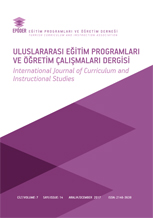
Uluslararası Eğitim Programları ve Öğretim Çalışmaları Dergisi
Yazarlar: Ebru Bakaç, Raşit Özen
Konular:-
Anahtar Kelimeler: Creativity perception,Teacher training,Creativity in teacher training
Özet: Abstract The aim of this descriptive research study is to determine whether presevice teachers’ perceptions of creativity differ based on certain variables.A survey design was used in this study. The study participants (n=429) were first year preservice teachers studying at the Faculty of Education at Abant İzzet Baysal University in the 2013-2014 academic year . The “How Creative Are You? ” scale developed by Whetton ve Cameron (2002) and adapted into Turkish by Aksoy (2004) was used to measure preservice teachers’ creativity perceptions. Descriptive statistics, Independent Sample t-test, and One- Way ANOVA were used to analyze the data. At the end of the study, preservice teachers’perceptions about creativity was found to be slightly higher than the moderate level. While a significant difference was not found between preservice teachers’ perceptions about creativitybased on gender, there was a significant difference based on the department they were studying at and their university entry score type.